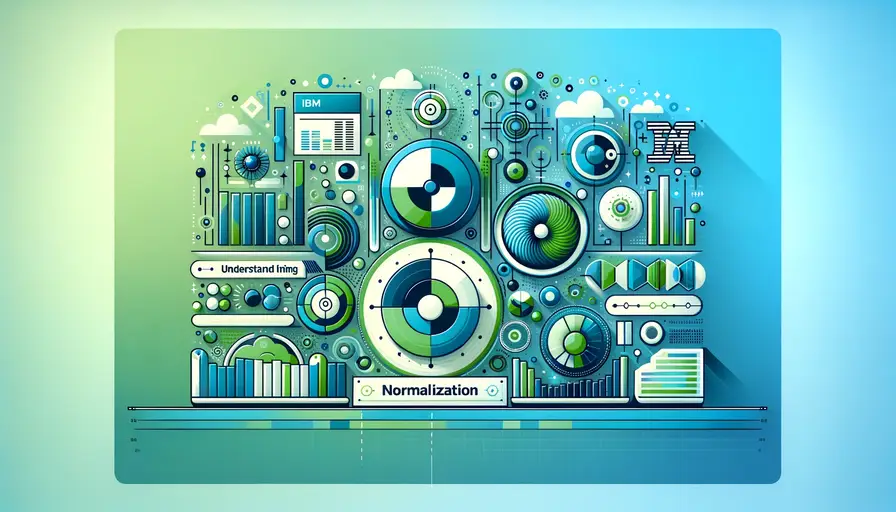Normalization is a Technique Used in Machine Learning to Scale the Features of a Dataset
Normalization is a fundamental technique in machine learning that scales the features of a dataset to a common range. This process ensures that no single feature dominates the model due to its scale. By transforming data to a standard scale, models become more robust and effective, leading to improved accuracy and performance.
Why is normalization important? It is essential because machine learning algorithms, especially those based on distance metrics, such as K-Nearest Neighbors (KNN) and Support Vector Machines (SVM), can be sensitive to the scale of input data. Without normalization, features with larger scales can disproportionately influence the model’s predictions, leading to biased and inaccurate results.
IBM’s approach to normalization involves a systematic process of transforming data into a standard scale. IBM employs various normalization techniques tailored to the specific requirements of the dataset and the machine learning model being used. These techniques help ensure that the features have similar ranges and distributions, thereby enhancing the performance and reliability of the models.
IBM’s Approach to Normalization in Machine Learning Involves Transforming the Data to a Standard Scale
Why is normalization important in machine learning? Normalization is crucial in machine learning because it helps maintain the balance between features, preventing those with larger numerical ranges from overshadowing others. This balance is particularly important in models that calculate distances, such as clustering algorithms and neural networks.
IBM’s approach to normalization is methodical and comprehensive. IBM utilizes techniques such as min-max scaling and z-score standardization to transform data. Min-max scaling rescales the data to a specified range, typically 0 to 1, while z-score standardization transforms the data so that it has a mean of zero and a standard deviation of one. These methods ensure that the data is on a comparable scale, enhancing model performance.
Benefits of IBM’s normalization approach include improved model accuracy, reduced training time, and enhanced model interpretability. By standardizing the feature scales, IBM’s normalization techniques minimize the influence of outliers and ensure that all features contribute equally to the model’s learning process. This approach helps in creating more robust and reliable machine learning models.
This Helps to Prevent Certain Features from Dominating the Model
Normalization prevents specific features with larger ranges from dominating the machine learning model. When features vary widely in scale, the model may disproportionately focus on the features with higher magnitudes, leading to skewed results and poor performance.
By scaling features to a common range, normalization ensures that each feature contributes equally to the model. This balance is essential for the model to learn effectively from all features, improving the overall accuracy and robustness of the predictions. IBM’s approach to normalization carefully considers the impact of each feature, ensuring that no single feature overwhelms the others.
Incorporating IBM’s normalization techniques, such as min-max scaling and z-score standardization, helps achieve this balance. These techniques transform the data so that each feature has a similar range, preventing dominance by any one feature and leading to more accurate and reliable models.
IBM Uses Various Normalization Techniques Such as Min-Max Scaling and Z-Score Standardization
Min-Max Scaling is a popular normalization technique used by IBM. This method transforms the data by scaling features to a specified range, typically between 0 and 1. Min-max scaling preserves the relationships between features while ensuring that all features contribute equally to the model’s learning process. This technique is particularly useful when the data has a known range and is effective in preventing dominance by features with larger scales.
Z-Score Standardization is another normalization technique employed by IBM. This method transforms the data so that it has a mean of zero and a standard deviation of one. Z-score standardization is beneficial when the data does not have a fixed range or contains outliers. By standardizing the data, this technique reduces the impact of outliers and ensures that all features are on a comparable scale, enhancing the model’s performance.
IBM’s approach to normalization often involves a combination of these techniques, depending on the specific requirements of the dataset and the machine learning model. By using both min-max scaling and z-score standardization, IBM can ensure that the data is appropriately scaled and that the model can learn effectively from all features.
These Techniques Ensure That the Features Have Similar Ranges and Distributions
Normalization techniques like min-max scaling and z-score standardization ensure that features have similar ranges and distributions. This is critical for machine learning models, as it prevents features with larger scales from dominating the model and skewing the results. By scaling features to a common range, these techniques promote a balanced learning process.
IBM’s normalization methods are designed to standardize the data, ensuring that all features contribute equally to the model. This standardization helps in reducing the bias that may arise from features with higher magnitudes. As a result, the model becomes more robust and accurate, leading to better performance and predictions.
The benefits of IBM’s normalization approach extend beyond just improving model accuracy. By ensuring that features have similar ranges and distributions, normalization techniques also enhance the interpretability of the model. This means that the relationships between features and the target variable become clearer, making it easier to understand and explain the model’s predictions.
Normalization Also Helps in Improving the Performance of Machine Learning Models by Reducing the Impact of Outliers
The Importance of Normalization in Machine Learning cannot be overstated. Normalization helps in improving the performance of machine learning models by reducing the impact of outliers. Outliers can significantly affect the model’s learning process, leading to biased and inaccurate predictions. By normalizing the data, these outliers are brought within a comparable range, ensuring that they do not disproportionately influence the model.
IBM’s Approach to Normalization in Machine Learning focuses on minimizing the impact of outliers through techniques like z-score standardization. This method transforms the data so that it has a mean of zero and a standard deviation of one, effectively reducing the influence of extreme values. By standardizing the data, IBM ensures that the model can learn effectively from all features, resulting in more accurate and reliable predictions.
Benefits of IBM’s normalization approach include improved model robustness and enhanced generalization. By reducing the impact of outliers, normalization helps in creating models that perform well on unseen data, leading to better generalization. This is particularly important in real-world applications where data can be noisy and contain outliers.
IBM’s Approach to Normalization Considers the Specific Requirements of the Dataset and the Model Being Used
IBM’s approach to normalization is tailored to the specific requirements of the dataset and the machine learning model being used. This customized approach ensures that the normalization techniques applied are appropriate for the data and the model, leading to better performance and accuracy. IBM’s approach considers factors like the range of the data, the presence of outliers, and the specific characteristics of the model.
Min-Max Scaling is a common technique used by IBM for normalization. This method transforms the data by scaling features to a specified range, typically between 0 and 1. Min-max scaling is particularly useful when the data has a known range and is effective in preventing dominance by features with larger scales. By scaling the data to a common range, IBM ensures that all features contribute equally to the model’s learning process.
Z-Score Normalization is another technique used by IBM. This method transforms the data so that it has a mean of zero and a standard deviation of one. Z-score normalization is beneficial when the data does not have a fixed range or contains outliers. By standardizing the data, this technique reduces the impact of outliers and ensures that all features are on a comparable scale, enhancing the model’s performance.
The Normalization Process is Typically Applied Before Training the Model on the Dataset
Normalization is typically applied before training the model on the dataset. This preprocessing step ensures that the data is appropriately scaled and standardized, allowing the model to learn effectively from all features. By transforming the data to a standard scale, normalization helps in improving the performance and accuracy of the machine learning model.
IBM’s approach to normalization involves applying techniques like min-max scaling and z-score standardization to the dataset before training. These techniques ensure that the features have similar ranges and distributions, preventing dominance by any single feature. This preprocessing step is critical for the model’s learning process, as it promotes balanced and effective learning from all features.
The benefits of applying normalization before training include improved model accuracy, reduced training time, and enhanced model interpretability. By standardizing the data before training, IBM ensures that the model can learn effectively from all features, resulting in more robust and reliable predictions. This preprocessing step is essential for creating high-performing machine learning models.
IBM Provides Tools and Libraries That Simplify the Process of Normalization in Machine Learning
IBM Watson Machine Learning is a powerful tool that simplifies the process of normalization in machine learning. This platform provides a range of tools and libraries that make it easy to preprocess and normalize data. With IBM Watson Machine Learning, users can apply various normalization techniques, such as min-max scaling and z-score standardization, to their datasets, ensuring that the data is appropriately scaled and ready for training.
IBM Cloud Pak for Data is another comprehensive platform that supports the normalization process. This platform offers a unified interface for data scientists and machine learning practitioners, providing tools for data preprocessing, normalization, and model training. With IBM Cloud Pak for Data, users can streamline their machine learning workflows, from data preparation to model deployment.
IBM Watson Studio and IBM Watson OpenScale are additional tools that support normalization and other preprocessing tasks. These platforms provide a range of features and capabilities that make it easy to preprocess and normalize data, ensuring that the data is ready for training and model development. By leveraging these tools, users can simplify the normalization process and improve the performance of their machine learning models.
Understanding IBM’s Approach to Normalization is Essential for Effectively Utilizing Their Machine Learning Solutions
Normalization Techniques are a critical aspect of IBM’s machine learning solutions. Understanding these techniques is essential for effectively utilizing IBM’s tools and platforms. By applying normalization techniques like min-max scaling and z-score standardization, users can ensure that their data is appropriately scaled and ready for training, leading to improved model performance and accuracy.
Normalization Methodologies employed by IBM focus on standardizing the data to a common scale, ensuring that all features contribute equally to the model’s learning process. These methodologies help in reducing the impact of outliers and preventing dominance by any single feature. By understanding and applying these normalization techniques, users can create more robust and reliable machine learning models.
The benefits of understanding IBM’s approach to normalization extend beyond just improving model performance. By leveraging IBM’s normalization techniques and tools, users can streamline their machine learning workflows, from data preparation to model deployment. This understanding is essential for effectively utilizing IBM’s machine learning solutions and achieving the best possible results from their models.


